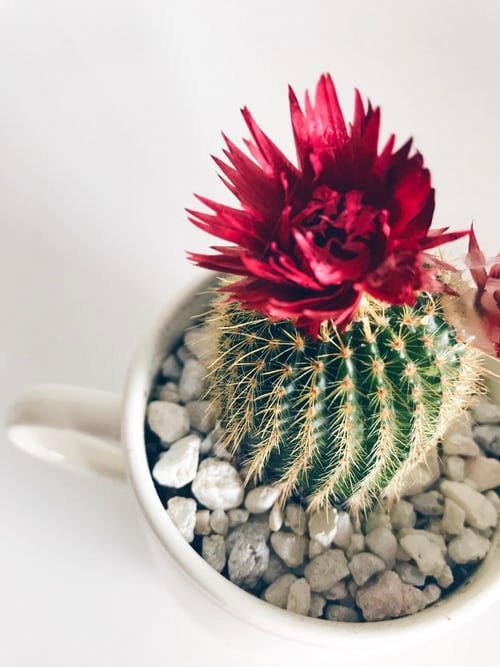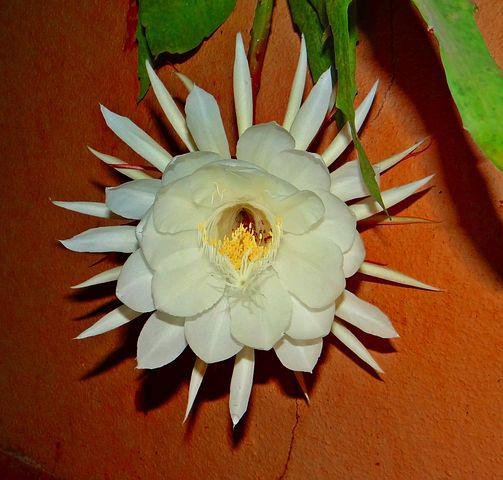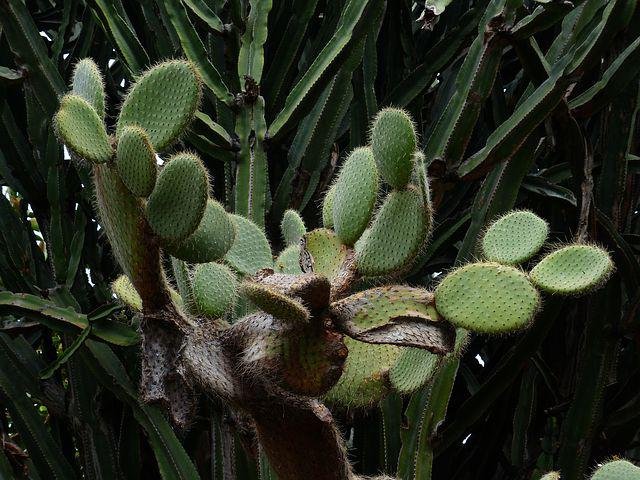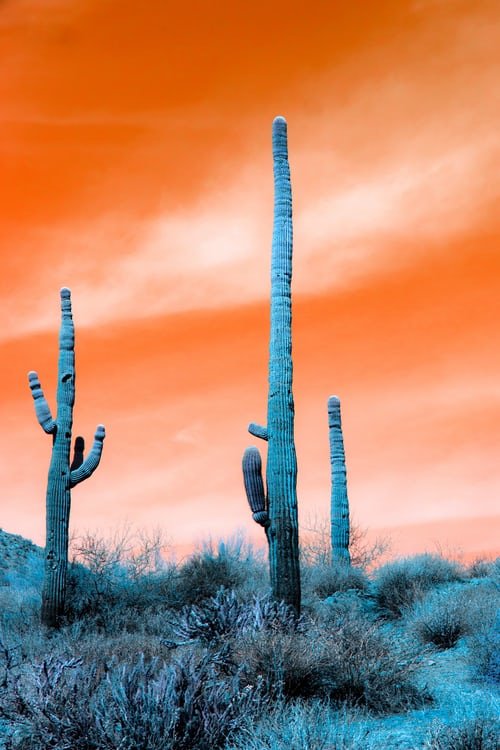Cactus, also called Cacti which belongs to the family Cactaceae, is a very unique and popular plant known for its wide variety of species which are very distinct in appearance. It is a flowering plant with nearly 2,000 species and 139 genera native to most of the length of North and South America.
Cacti are succulent perennial plants with thick herbaceous or woody Chlorophyll containing stems. They thrive in dry, hot climates, and unlike most plants, they need minimal amounts of water and thrive well in well-drained areas.
Cacti and succulent are two different terms that are often used interchangeably. Cacti are often identified by their needle-like spines and fleshy stems that store water and are capable of performing photosynthesis. At the same time, a succulent plant holds water and nutrients in its fleshy leaves.
Furthermore, cacti and succulent plants are closely related because cacti denote a botanical family. In contrast, succulents are a broader group that refers to a type of plant that is included in several botanical families. However, all cacti are succulents, but not all succulents are cacti.
Cacti stand out because of their areolas and small cushioned shapes that grow spikes, branches, or hair that define their family. At the same time, succulents don’t have areolas and are classified into different plant families. Though cacti are commonly referred to as desert plants, they can thrive in a home environment.
Types Of Cactus Plants
1. Golden Ball Cactus

Golden Ball Cactus (Echinocactus Grusonii) is a common desert ornamental known for its striking golden spines. It can grow up to 1 meter (3ft) high and 1 meter (3ft) wide.
This type of cactus is easily recognizable and is also the most popular type used in drought-tolerant areas. Depending on the growing conditions, this species can be ball-shaped or barrel-shaped.
USDA Growing Zone: 9-11
Color Varieties: Golden Yellow
Sun Exposure: Full sun
Soil Type: Rich, Fast-draining Cactus Mix.
2. Christmas Cactus

Christmas Cactus (Schlumbergera bridgesii) is a popular winter-flowering houseplant native to the Brazilian rainforests. The Christmas Cactus is a blooming succulent that is easy to care for and has gorgeous blooms that can like you for 100 years when properly taken care of.
USDA Growing Zone: 10-12
Color Varieties: Pink, Magenta, White or Purple, etc.
Sun Exposure: Partial
Soil needs: Moist, well-drained, loamy
3. Peanut Cactus

Peanut Cactus (Echinopsis Chamaecereus) is a branched cactus with many crowded pale green finger-like stems native to Argentina. It is a low-growing plant with bright or orange-red flowers making it a popular houseplant or addition to a cacti garden.
The peanut cactus grows up to 6 inches (10cm) tall, and its stems are up to 6 inches (15cm) long and 0.5 inches (1.2cm) in diameter. The peanut cactus prefers shallow containers and grows well in gardens and xeriscapes.
USDA Growing Zone: 10a to 11b
Color Varieties: Orange and red
Sun Exposure: Full sun
Soil Type: Well drained Soil
4. Saguaro Cactus

Saguaro Cactus (Carnegiea Gigantea) is a tree-like cactus composed of tall, thick, fluted columnar stems 18 to 24 inches. Saguaro Cactus is a slow grower that may take more than 100 years to reach its full tree-like, 40 to 60 feet.
USDA Growing Zone: 9
Color Varieties: White with a yellow center
Sun Exposure: Full sun
Soil Type: Succulent soil or cactus mix.
5. Star Cactus

Star Cactus (Astrophytum Asterias) is a cactus species native to small parts of Texas and Mexico. It is a slow-growing succulent houseplant known for its beautiful flowers and unique star-like appearance.
USDA Growing Zone: 9-11
Color Varieties: Yellow
Sun Exposure: Full Sun
Soil Type: Coarse, sandy soil, cactus mix.
6. Old Lady Cactus

Old Lady Cactus (Mammillaria Hahniana) is a type of Pincushion cactus belonging to the Mammillaria family with its genus of 250 species. It is a favorite powder puff type of cactus that is sun-loving and easy to care for.
USDA Growing Zone: 11-13
Color: Purplish and red
Sun Exposure: Full sun to partial shade
Soil Type: Rich, porous, cactus mix
7. Feather Cactus

Feather Cactus (Mammillaria Plumosa) is a species of flowering plant belonging to the Cactaceae family and native to various regions of North-Eastern Mexico. The feather cactus is an unusual or ornamental plant that comes along with dense white spines, which are very soft and feathery to touch.
USDA Growing Zone: 9a-11b
Color: White, Ivory, or Pink
Sun Exposure: Full sun, partial shade
Soil Type: Coarse sand or fine gravel
8. Prickly Pear Cactus

Prickly Pear Cactus, commonly called Opuntia, Nopal Cactus, or Paddle Cactus, represents a dozen of Opuntia genus in the family Cactaceae. They are identified by their white, flat, branching pads that look like large leaves.
Prickly Pear Cactus Companion plants include blue grama and side-oats grama grasses. However, when growing outdoors, it does not require fertilizing.
USDA Growing Zone: 9-11
Color Varieties: Orange, Yellow, Red, and Pink
Sun Exposure: Full Sun
Soil Type: Well-draining Soil
9. Claret Cup Cactus

Claret Cup (Echinocereus Triglochidiatus) is one of the most attractive cacti that grow up to 3-4 inches. Across. It is a small molding cactus widely cultivated for its flowers and for forming bulbous piles of up to hundreds of spherical to cylindrical blue, green stems usually erect. The Claret Cup Cactus is planted with sage, poppies, yucca, penstemon, and native grasses.
USDA Growing Zone: 9-10
Color Varieties: Blue Or Green
Sun Exposure: Full Sun
Soil: Gravel Soil
10. Moon Cactus

Moon Cactus (Gymnocalycium Mihanovichii) is a specie of Cactus native to South America’s deserts in Brazil, Argentina, and Paraguay. It is a popular indoor plant known for its small size and vibrant colors that grows 1 to 2 inches at mature size.
USDA Growing Zone: 11-12
Color Varieties: Yellowish Green
Sun Exposure: Partial Shade
Soil Type: Rich, Fast-draining Cactus Mix.
11. Barrel Cactus

Barrel cactus, also referred to as “Mother-in-law cushion,” belongs to the genera Echinocactus and Ferocactus and is native to the deserts of Southwestern North America. This type of Cactus is often characterized by its ribbed, cylindrical shape, and it comes in many sizes that may be low and squat or that may be as tall as 10feet (3m) in height.
USDA Growing Zone: 9-12
Color Varieties: Yellow, Tan, Red
Sun Exposure: Direct Sun
Soil Type: Sand, Topsoil, Perlite, Compost, and Cactus Mix
12. Beavertail Cactus

Beavertail Cactus (Opuntia basilaris) is a low-spreading cactus species with gray-blue, white, and flat fleshy pads that resemble beaver tails. They grow up to 6-12 feet tall (15-30cm) and 4 feet wide (120cm).
The Beavertail Cactus has dark Cherry pink flowers that almost grow and smell like watermelon. It also blooms in late winter to early summer and is ideal for desert landscaping and drought-tolerant gardens. Beavertail cactus looks attractive when teamed up with other species like Angelita Daisy and Barrel Cactus.
USDA Growing Zone: 8-10
Color Varieties: Fuchsia and Reddish Purple
Sun Exposure: Full Sun
Soil Type: Well-drained soil
13. Fairy Castle Cactus

Fairy Castle Cactus (Acanthocereus Tetragonus) is a columnar cactus native to North, South, and Central America. It is a type of cactus that is succulent with spines and blooms.
USDA Growing Zone: 10-11
Color Varieties: White
Sun Exposure: Full Sun
Soil Type: Well-drained Soil
14. Parodia Cactus

Parodia Cactus is a genus of flowering cactus plant that belongs to the Cactaceae family and is native to Argentina, Bolivia, Columbia, Brazil, and South America.
USDA Growing Zone: 10-12
Color Varieties: Blue-Green
Sun Exposure: Full Sun
Soil Type: Rich, Fast-draining Soil.
15. Orchid Cactus

Orchid Cactus (Ephiphyllum) is a genus of tropical succulents with over a dozen species of varying shapes and sizes. This type of Cactus has long, flat, non-spiny, and trailing stems that grow 2 ft ( 160cm) long and 2 inches (51m) wide
USDA Growing Zone: 10-11
Color Varieties: Red, White, Orange, Yellow, Pink, and Purple
Sun Exposure: Partial Sun
Soil Type: Well-drained
16. Organ Pipe Cactus

Organ Pipe Cactus (Stenocereus thurberi) is a cactus native to Mexico and Southern Arizona. It is a tall species of succulent and subspecies of the Cactaceae family that grows multiple green-skinned tubular limbs that resemble the pipes of a church organ.
Organ Pipe Cacti can reach up to 30 feet high with wide clumps. Although they tend to be smaller in most gardens, this species or cactus always makes an attractive statement in a courtyard patio garden and can be used in raised planters as hedges.
USDA Growing Zone: 9-11
Color Varieties: Green to Gray
Sun Exposure: Full Sun
Soil Type: Rich, well-draining soil
17. Blue Columnar Cactus

Blue Columnar Cactus (Picosocereus) is a cacti genus native to Mexico, the Caribbean, and Brazil. This species of cacti grow at elevations of (50-1550m) above sea level.
USDA Growing Zone: 9-11
Color Varieties: White, White-yellow
Sun Exposure: Sandy, Well-drained
Soil Type: Full Sun
18. Angel Wing Cactus

Angel Wing Cactus (Opuntia Microdasys), also called bunny ears cactus, is a species of cacti native to Mexico and desert regions stretching into Arizona. This type of Cactus grows 2-3 feet tall and spreads 4-to 6 at a mature plant.
USDA Growing Zone: 9a,9b,10a, 11a, 11b
Color Varieties: Yellow, White
Sun Exposure: Sandy, Well-draining
Soil Type: Full Sun
19. Dwarf Chin Cactus

Dwarf Chin Cactus ( Gymnocalycium Baldianum) is a flowering plant in the cactus family Cactaceae. It is a small cactus with a bulb-shaped body that measures up to 3-4 inches tall and 3-5 inches across.
USDA Growing Zone: 8b-11b
Color Varieties: Orange, Green
Sun Exposure: Partial Shade
Soil Type: Well-draining Cactus Mix
20. Lady Finger Cactus

Lady Finger Cactus (Mammillaria Elongata), also called gold lace cactus, is a flowering plant in Cactaceae. This cactus is a slow grower and an excellent addition to the home environment.
USDA Growing Zone: 9b to 11b
Color Varieties: Bright Pink, White To Yellow Center
Sun Exposure: Full Sun
Soil Type: Well-draining mix of potting soil with sand.
21. Strawberry Hedgehog Cactus

Strawberry Hedgehog Cactus (Echinocereus Stamineus), also called Engelmann’s Hedgehog Cactus, is a small clumping cactus that forms large colonies of 100 stems at maturity. It grows to 10-30cm and forms 2-3ft wide (60-90cm). Strawberry Hedgehog has ornamental spines that densely cover the surface of the plants, and they tend to be extremely sharp and attractive in rock and drought-tolerant gardens and other succulents and wildflowers.
USDA Growing Zone: 7a, 7b, 8a, 8b, 9a, 9b, 10a, 10b
Color Varieties: Purple and Pink
Sun Exposure: Full Sun
Soil Type: Well-draining Soil
22. Mammillaria Polyedra Cactus

Mammillaria Polyedra Cactus is a low-growing cactus with currently 200 known species. The Mammillaria Polyedra is one of the sweetest cactus varieties. They can span sizes from 1 inch in diameter (2-5cm) to 1 foot in height (30cm)
USDA Growing Zone: 9-10
Color Varieties: White or Red
Sun Exposure: Strong, Indirect Sun
Soil Type: Well-draining Soil
23. Rat Tail Cactus

Rat Tail Cactus (Aporocactus Flagelliformis or Disocactus Flagelliformis) is a cactus that grows 3 to 5 feet long. Redtail cactus produces beautiful flowers in spring and is best grown as a hanging plant.
USDA Growing Zone: 10a to 11
Color Varieties: Bright Pink to red
Sun Exposure: Direct Sun
Soil Type: Rich Potting Soil
24. Silver Torch Cactus

Silver Torch Cactus (Gleistocactus Straustii) grows up to 8 feet tall with blooms that are 3 inches long and tubular.
USDA Growing Zone: 9-11
Color Varieties: Rose or Burgundy
Sun Exposure: Full Sun to Partial Sun
Soil Type: Soil Amended With Sand
25. Totem Pole Cactus

The Totem Pole Cactus comes from Pacycereusb Schotti, with small wooly spines up to 4 inches (10cm).
USDA Growing Zone: 10a -11
Color Varieties: Bright Pink
Sun Exposure: Full Sun to Partial Shade
Soil Type: Cactus and Succulent Soil Mixture.
26. Turk’s Cap Cactus

Turk’s Cap Cactus, also known as Melocactus, is a species of cactus that is endemic to Brazil. It is a genus of around 37 perennial Cactus plants in the Cactaceae family. It grows about 2-4 inches tall and has a width of around 3-4 inches.
